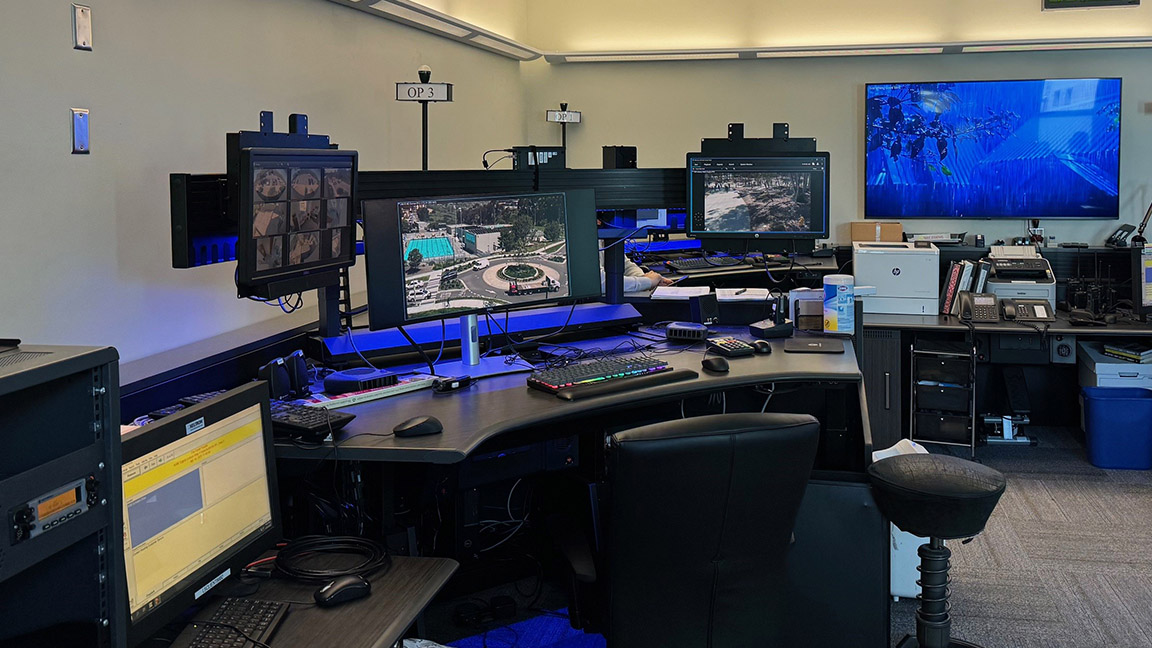
The University of California San Diego (UCSD) Police Department is a full-fledged law enforcement agency responsible for patrolling, investigating, and preventing crime within its jurisdiction. Spanning more than 1,200 acres and 900 buildings, UCSD’s campus presents unique challenges for law enforcement. The department’s Communications Division serves as the nerve center, coordinating responses to emergencies, managing communications, and ensuring coordination among officers.
[RGB Spectrum Releases the Zio Recording System]
With more than two decades of experience, Sgt. Garrett Williams oversees the Communications Division. Williams understands the critical role technology can play in public safety. He explained that before partnering with RGB Spectrum, UCSD faced significant obstacles in its dispatch operations, as dispatchers juggled multiple computers (computer aided dispatch, radio, and phone), each requiring separate keyboards and mice.
“Three separate mice and operators constantly moving side to side to look from one to the other and then having to move their hands back and forth between control devices—anytime they have to do that, it’s slowing their workflow down," recalled Williams. "And up to 25% of our operators were suffering from repetitive movement and neck injuries, resulting in downtime and light duty restrictions. We figured there had to be a better solution."
UCSD wanted a seamless KVM solution that integrated multiple systems over IP under a unified interface. It explored various options before discovering RGB Spectrum’s XtendPoint solution, which provides local and remote access to source computers, consolidates separate monitors into multi-view displays, and unifies control for more streamlined operation and enhanced efficiency.
[Download Today: The Integration Guide to KVM]
For UCSD, the key selling point was providing a solution to the ergonomic challenges plaguing dispatchers by minimizing the need for multiple keyboards and mice. Replacing monitor clutter was another plus. With the XtendPoint solution, each monitor can handle up to four computer signals. Plus, each operator can have customized display viewing, even in a multi-shift operation. Dispatchers can now access live video feeds and additional mission-critical systems directly within one system interface, providing them with real-time visual information as required.
A KVM-over-IP backbone offers additional benefits. Before, only one dispatcher station could see the fire alarm system. With RGB’s XtendPoint KVM system, UCSD expanded access to the fire alarm system at each operator’s station.
“The flexibility of the RGB system also allowed UCSD dispatchers to leverage video wall capabilities," Williams added. "They can easily share critical information and task lists with colleagues. A more collaborative environment has facilitated communication and coordination among dispatchers, ensuring that tasks are efficiently managed and prioritized during high-stress situations. We can use the RGB system to throw things up on the wall so other dispatchers can see what’s happening and interact as needed.”
The impact of XtendPoint KVM-over-IP on UCSD’s dispatch operations has been profound. UCSD witnessed significant improvements in efficiency, ergonomics, and situational awareness. Efficiency soared as dispatchers seamlessly controlled multiple systems from a single interface. Ergonomic issues were mitigated and dispatcher morale improved, enabling dispatchers to respond more effectively to emergencies.
Looking ahead, UCSD sees opportunities to leverage RGB Spectrum’s technology further to enhance operations. For example, in the event of a building evacuation or siege, UCSD could almost immediately establish a satellite facility. UCSD also aims to extend the reach of its dispatch operations by providing field personnel with access to real-time information. By equipping mobile units with RGB’s AV-over-IP systems via smartphones, police officers could receive critical updates and better collaborate with dispatchers to respond to incidents.
[Editorial: 'Intelligence' Can Be Artificially Overrated]
“If you think of the unthinkable, like a school shooting, it would be ideal to share live coverage of what’s happening, detailed building schematics, and info on weapons the assailant might be using. Who doesn’t want to know what’s potentially happening behind closed doors before walking in?" Williams said. "It’s situational awareness on a whole new level."





!["[T]he First and Fifth Amendments Require ICE to Provide Information About the Whereabouts of a Detained Person"](https://images.inkl.com/s3/publisher/cover/212/reason-cover.png?w=600)

